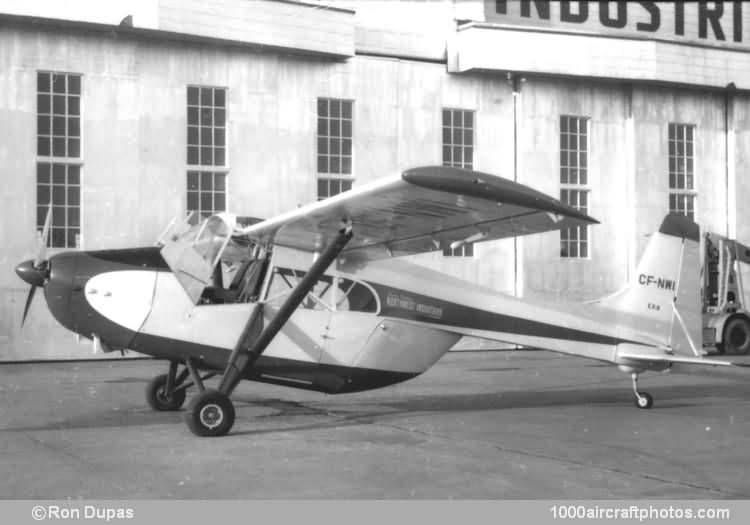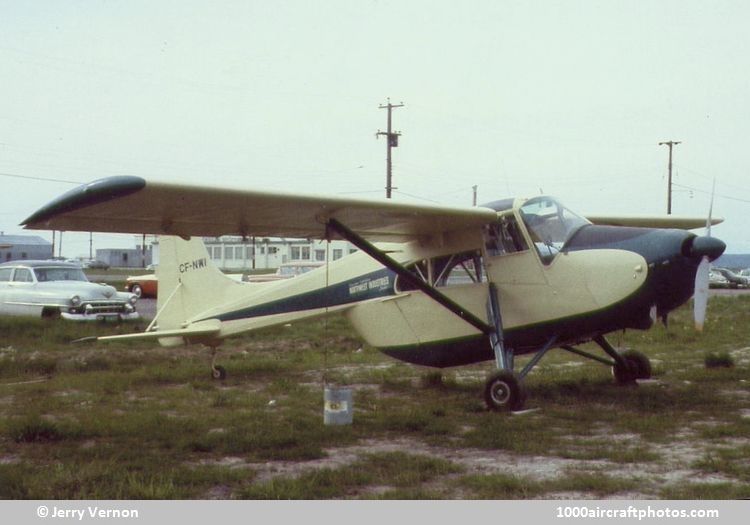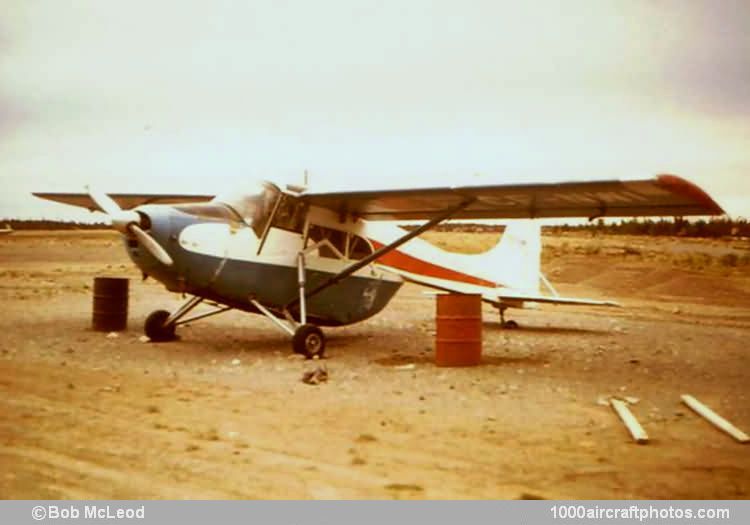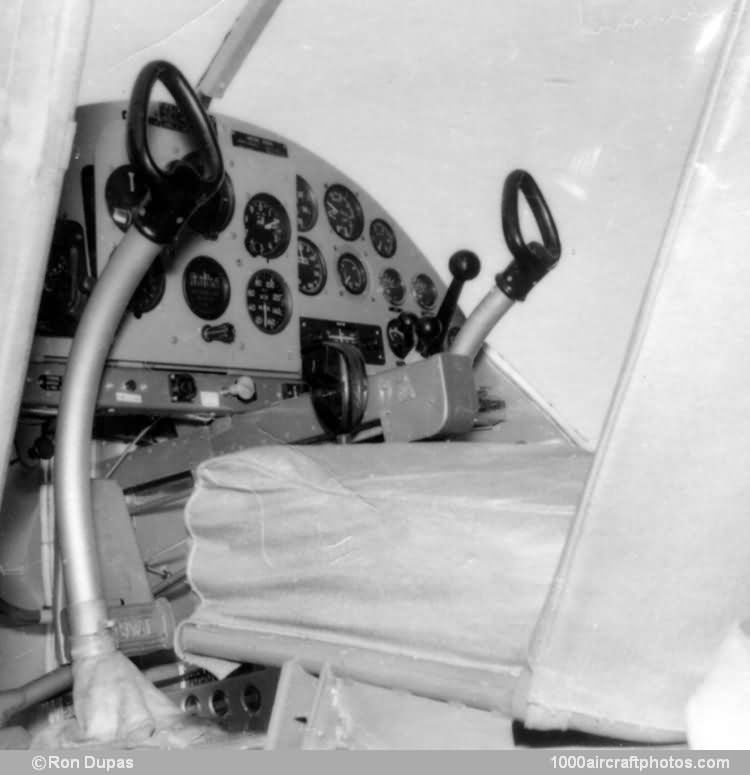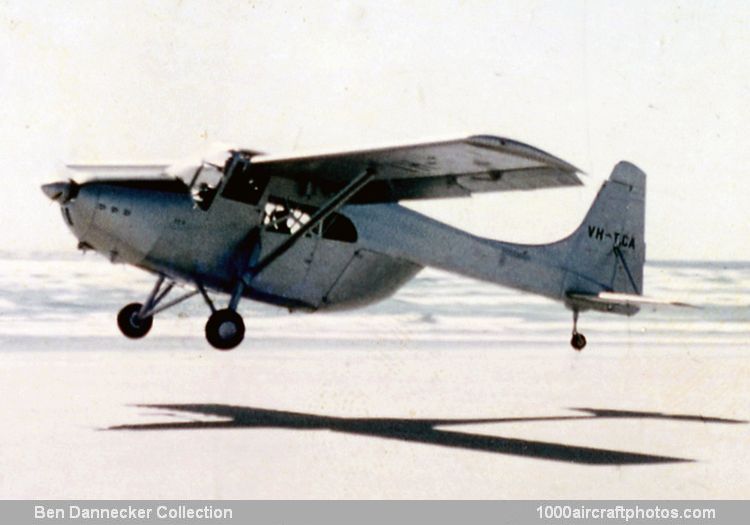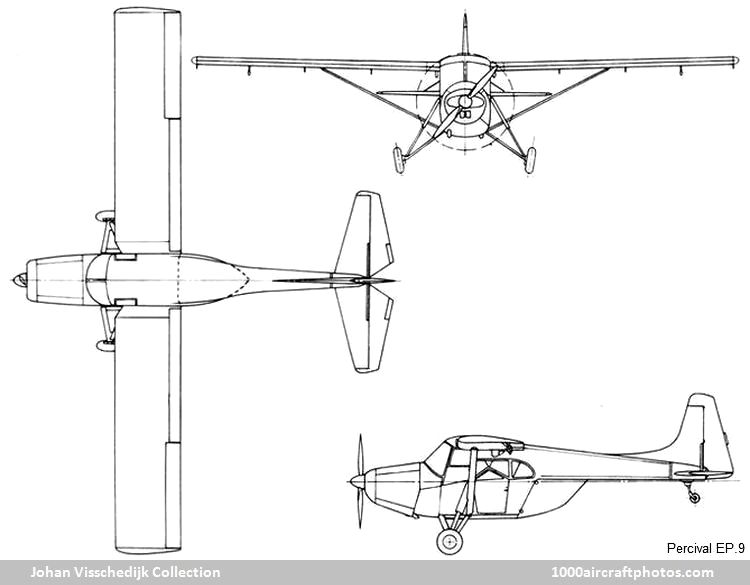07/31/2014.Remarks by
Johan Visschedijk: "The pictured aircraft was first flown from Stapleford Tawney in July 1957, under the British '
Class B' marking G-43-2.
(CF-NWI) (
Johan Visschedijk Collection)
Subsequently it was registered in Canada as CF-NWI to Northwest Industries Ltd. of Edmonton, Alberta, which became the Canadian distributor for the Percival E.P.9 (later the Lancashire Prospector EP.9).
In 1968 the aircraft had a mishap, read the excerpt of a
chapter about the crash landing of CF-NWI from
Jane Gaffin's book, "Edward Hadgkiss: Missing in Life".
(CF-NWI) (
Bob McLeod Collection)
By the time it was pictured by Bob McLeod in 1973 it was no longer owned by Northwest, as on September 23, 1971 it had been reregistered to James Mcavoy of Thorsby, Alberta. Since February 28, 1995 the aircraft is registered to Stan Reynolds Sales Ltd., owner of the Reynolds Aviation Museum at Wetaskiwin.
Edgar Wikner Percival (February 23, 1897 – January 23, 1983), Australian-born designer, builder and pilot of the world famous Percival Gull series, had resigned from Percival Aircraft Ltd. in 1939, but re-entered the British aircraft industry in 1955 and established a small factory at Stapleford Tawney Aerodrome (presently Stapleford Airport), Essex. Here was constructed a private venture single-engined agricultural aircraft known as the Percival P.9, based on ideas formulated during a tour to New Zealand in 1953.
The prototype, powered by a 270 hp Lycoming GO-480-B1B, was registered at Edgar Percival's private address in London, UK, as G-AOFU (c/n 20) on November 1, 1955, and the designer piloted the prototype on its maiden flight on December 21, 1955. During subsequent development flying the only major modification found necessary was the addition of a curved dorsal fin.
The unusual pod-and-boom fuselage configuration was dictated both by agricultural and aerodynamic considerations. It permitted an extra deep front fuselage capable of carrying a metric ton (2,205 lb, 1,000 kg) of fertilizer in a special hopper, discharging through a 20 in (51 cm) slit in the bottom of the fuselage. Two pilots sat high in the front with the perfect view so necessary for low-level flying. Flown as a utility transport without the hopper, the Percival P.9 boasted a cabin with 45 sq.ft (4.18 m) of floor area and sufficient headroom for an adult to stand upright. It would accommodate four passengers, three stretcher cases and attendant, or a variety of rural loads, the side and rear clamshell doors being large enough to take standard wool and straw bales, 54 gal (200 l) oil drums or small livestock.
Cockpit of CF-NWI (
Ron Dupas Collection)
Only in a low-slung pod-type fuselage was such a variety of loadings possible without excessive center of gravity travel. A high wing layout was chosen to keep the stressed skin, alloy covered mainplane clear of chemical corrosion, while the fuselage was a welded steel tube structure, fabric covered aft but with a light alloy skin over the cabin and cockpit section. Fuel for 41 hours flying was housed in wing root tanks, and the wing itself was equipped with full-span flaps and drooping ailerons to give exceptional low-speed control when operating in and out of farm fields.
To avoid confusion with Hunting Percival products, the designation of the aircraft was changed to Edgar Percival E.P.9 (né Prospector) in November 1956, by which time a batch of some twenty production aircraft (c/n 21 to 40) had been laid down. Several were sold in the Commonwealth, one to the French concern S.A. Fenwick and two (c/n 38 and 39, s/n XM797 and XM819) were submitted to Boscombe Down in military marks for Army evaluation, but the majority demonstrated their remarkable versatility while operating as British civil aircraft overseas. The first to go overseas (c/n 22) was shipped to Manawatu Aerial Topdressing Co. Ltd. of Christchurch, New Zealand, where it was registered ZK-BDP.
In March 1957 the third production aircraft, G-AOZY (c/n 23), was delivered to the German concern Ernst Lund A.G. for spraying fruit crops, insecticide from the 204 gal (772 l) tank being distributed through nozzles in underwing booms to spray a swathe 90 ft (27 m) wide at 100 mph (161 kmh). It was destroyed in a flying accident while spraying near Wunstorf a couple of months later and was replaced by the sixth production aircraft, G-APBF (c/n 26), which in May 1957 had completed a demonstration tour of Sweden. From September 1957 this machine was in continuous daily use on pest-control duties all over Germany until it collided with a tree a year later.
The next aircraft, G-APAD (c/n 27), which left the works in April 1957, was fitted with four seats in the cabin, crated and shipped to Australia, where it was demonstrated for six weeks by EP.9 sales pilot Beverley Snook. Subsequently the aircraft was stored at Moorabbin Airport, Melbourne.
Following this tour, orders were received for four E.P.9s, which all completed the 14,000 mls (22,530 km) delivery flight to Australia without incident an impressive feat for a single-engined agricultural type. First of these, G-APBR (c/n 28), originally shown at the Paris Aero Show in June 1957 and subsequently demonstrated in Spain and North Africa by H. Best-Devereux, was acquired, together with G-APFY (c/n 32), by Super Spread Aviation (Pty.) Ltd. of Melbourne. Carrying miscellaneous freight, including a racing-car engine in each, G-APBR and G-APFY were flown from England to Australia by Super Spread founders and directors Austin Miller and Ernie Tadgell, who departed London on September 19, 1957, making 32 stops before reaching home base at Moorabbin. The aircraft were reregistered VH-SSV and
VH-SSW respectively.
The second pair, the all red G-APIA and G-APIB (c/n 33 and 34), left Croydon, UK on delivery to Skyspread Australia, Sydney on October 27, 1957. These were piloted by well-known Australian pilots A.J.R. 'Titus' Oates and J.L.D. 'Wac' Whiteman, accompanied by the EP.9 sales pilot Beverley Snook; they reached Darwin on November 19. These two were respectively reregistered VH-FBY and VH-FBZ.
A fifth E.P.9 (c/n 31), test flown in the UK with 'Class B' marking G-43-1, was shipped to Proctors' Rural Services Pty. Ltd. of Alexandra, Victoria, Australia, where it was registered as VH-PRS. The sixth EP.9 for Australia was the stored G-APAD (c/n 27), which was registered to Super Spread Aviation on September 8, 1958, to replace their crashed VH-SSW (c/n 32). Erroneously the aircraft was allotted the registration VH-SSW again, at that time it was a policy not to reissue the registration of a crashed aircraft, so the aircraft was reregistered VH-SSX on December 8, 1958.
(VH-TCA) (
Ben Dannecker Collection)
A seventh EP.9 (c/n 40) became VH-TCA.
Three others, G-APCR, G-APCS and G-APCT (c/n 21, 24, 25), left Croydon in September 1957 on delivery to Bahamas Helicopters (UK) Ltd. for light freighting and communications duties in connection with the oil drilling contract in Libya. British domestic use of the E.P.9 was confined to two aircraft, mainly because of import restrictions on American engines for installation in British-owned machines.
The prototype G-AOFU, acquired by L. Marmol of Air Ads Ltd., Stapleford, in June 1957 was intensively employed in its primary role as a crop sprayer; after a mishap it was written-off on November 3, 1962. G-APLP (c/n 35) was temporarily employed for a similar purpose by the Bembridge, Isle of Wight firm, Crop Culture (Aerial) Ltd. G-AOZO appeared at most major air displays during 1957, and in April 1958 was flown to Ostersund, Sweden, by L. Marmol for demonstration on skis to the military authorities.
In November 1958 Edgar Percival Aircraft Ltd. was taken over by Samlesbury Engineering Ltd., together with G-AOZO, G-AOLP, seven unfinished airframes and all the jigs. The company was then renamed the Lancashire Aircraft Co. Ltd. and production was moved to Samlesbury, Lancashire, where a further five additional airframes the aircraft were built (c/n 42 to 46, including one uncompleted aircraft, c/n 45) under the revised designation Lancashire Prospector E.P.9. These were fitted with a higher powered 295 hp Lycoming GO-48O-G1A6 engine.
Conversions with a 375 hp Armstrong Siddeley Cheetah 10 radial engine became available, the first was Skyspread's VH-FBZ (referred to as EP.9C), converted at Sydney at the end of 1959. Intensive sales drives included spraying and passenger carrying demonstrations by G-AOZO and G-APWX respectively in Austria at the Vienna International Trade Fair in March 1960, by G-AOZO in Germany at the Hanover Air Show a month later and an African sales tour by G-APWX flown by the Earl of Bective, Lancashire's sales manager.
Finally, a single Prospector E.P.9 Mark 2 (G-ARDG, c/n 47) was built, fitted with a 410 hp Cheetah 10 radial engine, it first flew in August 1960. However, shortly thereafter it was decided to cease production with a grand total of 27 E.P.9s having been completed; by 1964 the company had ceased operations."
